A beard is the hair that grows on the jaw, chin, upper lip, lower lip, cheeks, and neck of humans.
Beard hair is most commonly removed by shaving or by trimming with the use of a beard trimmer.
For appearance and cleanliness, some people maintain their beards by exfoliating the skin, using soap or shampoo and sometimes conditioner, and afterward applying oils for softness.
Throughout the course of history, societal attitudes toward male beards have varied widely depending on factors such as prevailing cultural-religious traditions and the current era's fashion trends.
Here are a few popular terms you should know if you wish to be a master of understanding facial hair. If you are not familiar with these terms, you will most certainly appear foolish in front of your friends.
- Moustache = If only the area above the upper lip is left unshaven, that hair is the moustache.
- Goatee = if hair is left only on the chin, the style is a goatee.
- Sideburns: hair grown from the temples down the cheeks toward the jawline.
Beard styling comes in a wide variety of styles.
Here are a few of the various options:
Circle beard: Commonly mistaken for the goatee, the circle beard is a small chin beard that connects around the mouth to a moustache. Also called a doorknocker.
Closed or Tied beard: Mostly seen among modern Sikh youth, this is a kind of full beard tied by using a sticky liquid or Gel and stiffens below the chin.
Designer stubble: A short growth of the male beard that was popular in the West in the 1980s, and experienced a resurgence in popularity in the 2010s. In the opinion of Apparel Search, this style will retain its popularity.
French Fork Beard: Pirate Jack Sparrow (Captain Jack Sparrow) has made this beard style cool again. The name based on the fact that French forks originally only had 2 prongs.
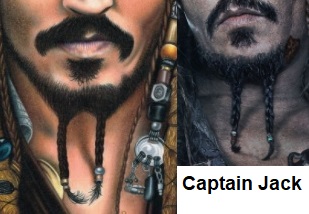
Friendly mutton chops: long mutton chop-type sideburns connected to a mustache, but with a shaved chin.
Full: downward flowing beard with either a styled or integrated moustache
Garibaldi: wide, full beard with rounded bottom and integrated moustache. Popularized by Giuseppe Garibaldi who was an Italian general.
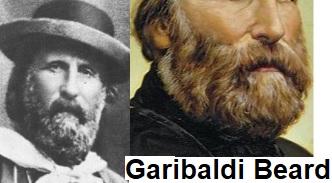
Glitter beard: Beard dipped in glitter. More of an embellishment to a beard than a trimming style.
Goatee: A tuft of hair grown on the chin, sometimes resembling a billy goat's. Although it resembles an animals face, many men enjoy this style.
Hulihee: clean-shaven chin with fat chops connected at the moustache.
Jawline beard: A beard that is grown from the chin along the jawline. Chinstrap, chin curtain and brett are all variations of a jawline beard with distinctions being chin coverage and sideburn length.
- Chinstrap: a beard with long sideburns that comes forward and ends under the chin.
- Chin curtain: similar to the chinstrap beard but covers the entire chin. Also called a Lincoln, Shenandoah, or spade.
- Brett: similar to the chin curtain beard, but does not connect to the sideburns.
Lincoln: looks much like the Amish old dutch, but more tidy.
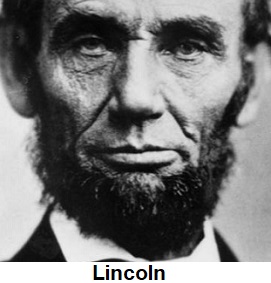
Junco: A goatee that extends upward and connects to the corners of the mouth but does not include a mustache, like the circle beard.
Long Beard: yes, this is a beard that is long in length.
Meg: A goatee that extends upward and connects to the mustache, this word is commonly used in the south east of Ireland.
Monkey tail: a Van Dyke as viewed from one side, and a Lincoln plus
moustache as viewed from the other, giving the impression that a monkey's
tail stretches from an ear down to the chin and around one's mouth.
Hollywoodian: a beard with an integrated mustache that is worn on the lower part of the chin and jaw area, without connecting sideburns.
Neckbeard (a.k.a. Neard, a portmanteau of "neck" and "beard"): similar to the chinstrap, but with the chin and jawline shaven, leaving hair to grow only on the neck. While never as popular as other beard styles, a few noted historical figures have worn this type of beard, such as Nero, Horace Greeley, Henry David Thoreau, William Empson, Peter Cooper, Moses Mendelssohn, Richard Wagner, and Michael Costa.
Oakley beard: Described by Indian makeup artist Banu as "neither a French beard nor a full beard". She used the look for Rajinikanth in Enthiran (2010).
Old Dutch or The Amish: A large, long beard, connected by sideburns, that flares outward in width at the bottom, without a mustache. This Full Beard is worn square and without a mustache. Sometimes the top of the chin is left bare too.
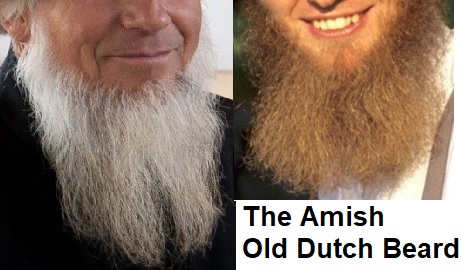
Sea captain: A rounded, bottom-heavy beard of medium length with short sides that is often paired with a longer mustache.
Short Boxed Beard: This is the traditional way of wearing a Full Beard. Your sideburns, mustache and beard combine to form an all-in-one display of masculinity. By shaving your upper cheeks and your neck and trimming the rest, you define the shape and keep the whole thing tidy. A classic beard look.
Soul patch: a small beard just below the lower lip and above the chin. A soul patch is a single small patch of facial hair just below the lower lip and above the chin. It came to prominence in the 1950s and 1960s. It became popular with beatniks, artists, and those who frequented the jazz scene and moved in literary and artistic circles.
Stiletto beard: Rounded at the sides and perfectly pointed at the end, this style is harder to achieve than most men realize, but it looks great when combined with short hair. You may need some gel to shape your beard correctly into a kind of ducktail shape.
Muslim beard: Full beard with the moustache trimmed
Reed: a beard with an integrated mustache that is worn on the lower part of the chin and jaw area that tapers towards the ears without connecting sideburns.
Royale: a narrow pointed beard extending from the chin. The style was popular in France during the period of the Second Empire, from which it gets its alternative name, the imperial or impériale.
Stashburns or the Lemmy: sideburns that drop down the jaw but jut upwards across the mustache, leaving the chin exposed. Similar to friendly mutton chops. Often found in southern and southwestern American culture.
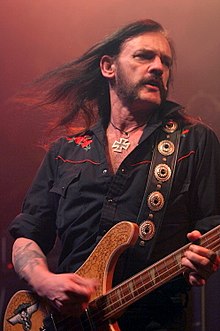
- Ian Fraser Kilmister (24 December 1945 – 28 December 2015), better known as Lemmy, was an English musician who was the founder, lead singer, bassist, primary songwriter, and only continuous member of the rock band Motörhead.
Van Dyke: a goatee accompanied by a moustache. A Van Dyke (sometimes spelled Vandyke, or Van Dyck ) is a style of facial hair named after the 17th-century Flemish painter Anthony van Dyck (1599–1641). A Van Dyke specifically consists of any growth of both a moustache and goatee with all hair on the cheeks shaved. Even this particular style, though, has many variants, including a curled moustache versus a non-curled one and a soul patch versus none. The style is sometimes called a "Charlie" after King Charles I of England, who was painted with this type of beard by van Dyck. "Pike-devant" or "pickedevant" are other little-known synonyms for a Van Dyke beard.
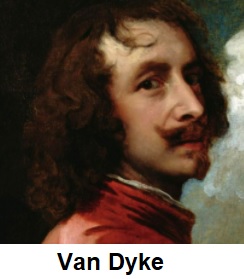
Verdi: a short beard with a rounded bottom and slightly shaven cheeks with a prominent moustache. Named after the composer.
- Giuseppe Fortunino Francesco Verdi was an Italian composer best known for his operas.
How to use a beard trimmer? Well, we suggest you read the directions that came with your trimmer.
If you read information on the internet, you will certainly find a wide variety of suggestions.
- Use a beard trimmer to control how much you take off. Glide the head of the trimmer over your face slowly, using light pressure. If your goal is to thin out a bushy beard, use upward strokes, so that the blades of the trimmer cut square across the hairs.
- Trim downwards, towards the jawline, in the direction of your beard's growth and repeat on both sides to maintain a beard balance on both sides.
- Work your way from the outside and trim down the flyaways to tighten the shape of your beard.
Here are a few suggestions of where to go to find a good beard trimming guide for reference:
Phillips - How to Trim a Beard : From the carefully clipped goatee to the thick, full neck-warmer, facial hair is always a bold statement of style. But that doesn’t mean a beard can be left to its own devices. Keep yours in line – and avoid bluebeard comparisons – with their ultimate beard trimming guide, packed with tips.
Gillette - How to Shave - find face shaving tips from an industry leader.
What are the best beard trimmers?
Consumer reports actually has a report on the best beard trimmers.
Probably a good idea to read up on manscaping and personal grooming.
|
|
You may wish to view some of our previous beauty industry news articles from our beauty articles section.
